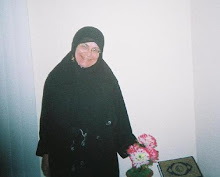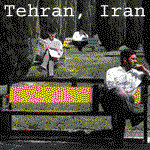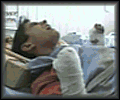Israel/Occupied Territories: Amnesty International delegate visits scene of Gaza Strip killings
 A Palestinian father despairs after his whole family was killed in Beit Hanoun (MaanImages)
A Palestinian father despairs after his whole family was killed in Beit Hanoun (MaanImages)AMNESTY INTERNATIONAL PRESS RELEASE
AI Index: MDE 15/087/2006
(Public)News Service No: 288
8 November 2006
The killing this morning of 18 civilians in the Palestinian town of Beit Hanoun, victims of Israeli shelling, was an appalling act, Amnesty International said today. The organization called for an immediate, independent investigation and for those responsible to be held accountable. It said previous Israeli investigations, such as that carried out into the killings of a Palestinian family on a beach in the Gaza Strip last June, had been seriously inadequate and failed to meet international standards for such investigations, which must be independent, impartial and thorough.
Those killed, most of whom were asleep in their beds when their homes were struck by shells fired by Israeli forces, included eight children. An Amnesty International delegate who visited the scene of the killings shortly after the attack was told that 15 of the victims were killed in the first strike and that three others were killed by a second shell as they raced to help the dead and injured.
“This terrible act follows a renewed upsurge in killings of Palestinians since Israel forces launched their latest military operation into the Gaza Strip on 2 November,“ said Malcolm Smart, Director of Amnesty International’s Middle East and North Africa programme. “Israeli actions during this entire operation have been marked by nothing less than reckless disregard for the lives of Palestinian civilians, over 20 of whom had been killed even before this morning’s tragedy.”
In all, before today’s deaths, more than 53 Palestinians were killed during the Israeli military siege of Beit Hanoun in the northern Gaza Strip, and many more were wounded. Two ambulance workers were among the civilians killed. Dubbed “Autumn clouds”by the Israeli army, the operation began on 2 November and continued until 7 November when Israeli forces redeployed outside the town. Israeli authorities said they mounted the operation in an attempt to prevent Palestinian armed groups firing home-made Qassem rockets at Israeli towns and villages near to the Gaza Strip. Most of the dead were killed in Beit Hanoun, which was kept under siege throughout the six days, but others were killed as a result of Israeli military strikes in the surrounding area.
Amnesty International condemns all attacks on unarmed civilians and is calling on the Israeli authorities to establish independent investigations into every incident in which Palestinian civilians were killed or injured by Israeli forces, and to bring to justice those responsible for human rights violations.
As Israeli forces began their siege of Beit Hanoun, one senior officer, Lieutenant Colonel Yarom, said that troops had been instructed to avoid causing civiliancasualties. Four days into the operation, in face of a rising toll of deaths and injuries among Palestinian civilians, Israel’s Prime Minister Ehud Olmert declared:“Those Palestinians who have been wounded were mostly armed, but, to our regret,they are using innocent people as human shields, resulting in the injury ofuninvolved civilians as well”.
The information gathered by Amnesty International delegates currently in the Gaza Strip contradicts this, however, and indicates that at least half of those killed, including at least two women and several children, were unarmed bystanders not involved in the confrontations. The pattern is the same for those injured as a result of Israeli force air strikes and artillery shelling.
Those killed or injured as a result of Israeli attacks include:
- Ramzi al-Ashrafi, 16, was killed and seven other children were injured on the morning of 6 November when an Israeli shell exploded close by the bus on which they were travelling to school along a busy road between Beit Lahia and Jabalya, north of Gaza City. Najwa Khleif, a 20-year-old teacher who was also in the bus, sustained severe brain injuries. Doctors treating her in the intensive care unit of Gaza City’s main hospital told Amnesty International that she was in critical condition. The bus was hit apparently in a failed strike by Israeli forces on a vehicle believed to belong to a Palestinian armed group. However, the attack was carried out at a busy intersection during the morning rush hour, when it could be expected that the streets would be busy with adults and children making their way to work and school. The shell which killed Ramzi al-Ashrafi and injured others in the school bus, fell near a kindergarten although, fortunately, without causing further deaths or injuries there.
- Ala’ Mansour al-Khdeir, an 11-year-old girl, one of two children who were wounded by Israeli fire on 4 November when they were returning home from a morning at school in Beit Lahia. She was struck by a bullet which entered the left side of her head and travelled to the left side of her neck, where it remains lodged, and remains seriously ill. Her mother told Amnesty International that Ala’was near home in the Sayafa area of north-west Gaza, an area where there has been frequent Israeli army shelling in recent days, when she was wounded. The other child, a boy, was also seriously injured.
- Ibtisam Masoud, 44, was killed and ten other women, including Tahrir Shahin, a 37-year-old mother of seven, were injured by Israeli fire during a women’s demonstration on the morning of 3 November at the entrance of Beit Hanoun. Tahrir Shahin, whose leg had to be amputated, told Amnesty International from her hospital bed in Gaza city that she and other women were unarmed and standing less than 100 meters from the Israeli tanks which fired at them: “Ours was a peaceful demonstration, we were all women, there were no men, no militants, no weapons. We were just women standing in front of tanks. We did not think the Israeli soldiers would shoot us, but they fired indiscriminately”.
- Heba Rajab, 20, a volunteer with the Palestinian Centre for Democracy and Conflict Resolution, and Sou’ad Abu Najem, 43, a mother of eight, both sustained serious gunshot wounds to their legs and hands in the same incident. They said they had seen Israeli soldiers taking aim at the women demonstrators from the tops of their tanks. The women were demonstrating in response to a call by a Hamas party member of the Palestinian parliament to help break the siege by Israeli forces of a mosque in which members of Palestinian armed groups were reported to be sheltering, surrounded by Israeli forces. However, the women were shot before they could approach the mosque.
- Ahmad al-Madhoun, 42, and Mustapha Habib, 26, both volunteer emergency ambulance workers with the Palestinian Red Crescent Society (PRCS), and a third man who was assisting them, were killed in an Israeli air strike on the evening of 3 November as they were evacuating the body of a man killed in an earlier air strike. Iyad Yousef Abu al-Ful, the ambulance driver accompanying them, told Amnesty International: “Ahmad and Mustapha were about 20 meters from the ambulance and were about to load the body of a dead man on the stretcher; I had just got out of the ambulance and was beginning to move towards them when a missile struck at the spot where they were. I got back into the ambulance and called for help. I cannot get out of my mind the sight of my colleagues killed while they were doing their duty”. The medical rescue team was in an open field near Beit Lahia. It was dark but the ambulance should have been clearly visible from the emergency light on its roof. The other victim had directed the ambulance crew to the body of his friend, who had been killed earlier in unclear circumstances.
Palestinian ambulances have been frequently attacked and dozens have been hit by Israeli strikes in recent years. During the siege of Beit Hanoun, emergency rescue workers faced increased obstacles and delays in carrying out their duties due to the virtually continuous curfew imposed by Israeli forces. Israeli tanks controlled the access to Beit Hanoun hospital and delayed the passage of ambulances in and out of the hospital, as well as into and out of the town.
- Zahir Mustapha Shabat, 32, was shot and seriously injured and his cousin, Mazen Shabat, was killed by Israeli soldiers in the evening of 4 November when they were returning home after they had both been released from three days’ detention by the Israeli army. He told Amnesty International from his hospital bed, shortly after he was moved from the intensive care unit: "After three days in detention the soldiers released us and gave us a paper, which they said we could show if we got stopped by other soldiers on our way home, about 1.5 to 2 km from the place where we were detained. They told us that they had coordinated with the tanks in the area and that we would have safe passage home but when we got about 150 meters from my house soldiers jumped out of the house of one of my relatives and fired on me and my cousin, Mazen, Shabat. Mazen was killed and I was seriously injured in the abdomen and back."
For interviews, please contact Amnesty International's researcher Donatella Rovera in Gaza on +970 599 446 703 or +44 7771 796 091, or Amnesty International's Middle East and North Africa press officer Nicole Choueiry on +44 7831 640 170















0 Comments:
Post a Comment
<< Home